BTEC HND Unit 2: Marketing Essentials Report - Lazada Group
VerifiedAdded on 2021/08/10
|19
|4231
|355
Report
AI Summary
This report provides a detailed analysis of the marketing essentials for Lazada Group, an international e-commerce company. The report begins with an introduction to Lazada, its operations, and its presence in Southeast Asia, followed by an explanation of the role of marketing and its importance in building relationships with customers, conducting market research, creating products, and providing information to customers. The report then explains the functions of the marketing department, including environmental analysis, consumer analytics, product planning, distribution planning, promotion planning, and pricing planning. The report also explores the interrelationships between marketing and other functional units within an organization, such as human resources and finance, and how marketing strategies can engage stakeholders to achieve business objectives. The report concludes with an overview of Lazada's marketing activities and its adaptation to the business-to-consumer (B2C) and business-to-business (B2B) environments, and the different marketing orientations such as production, product, sales, and marketing orientation. The report aims to persuade the board of directors of the importance of the marketing department and its role in the company's success.
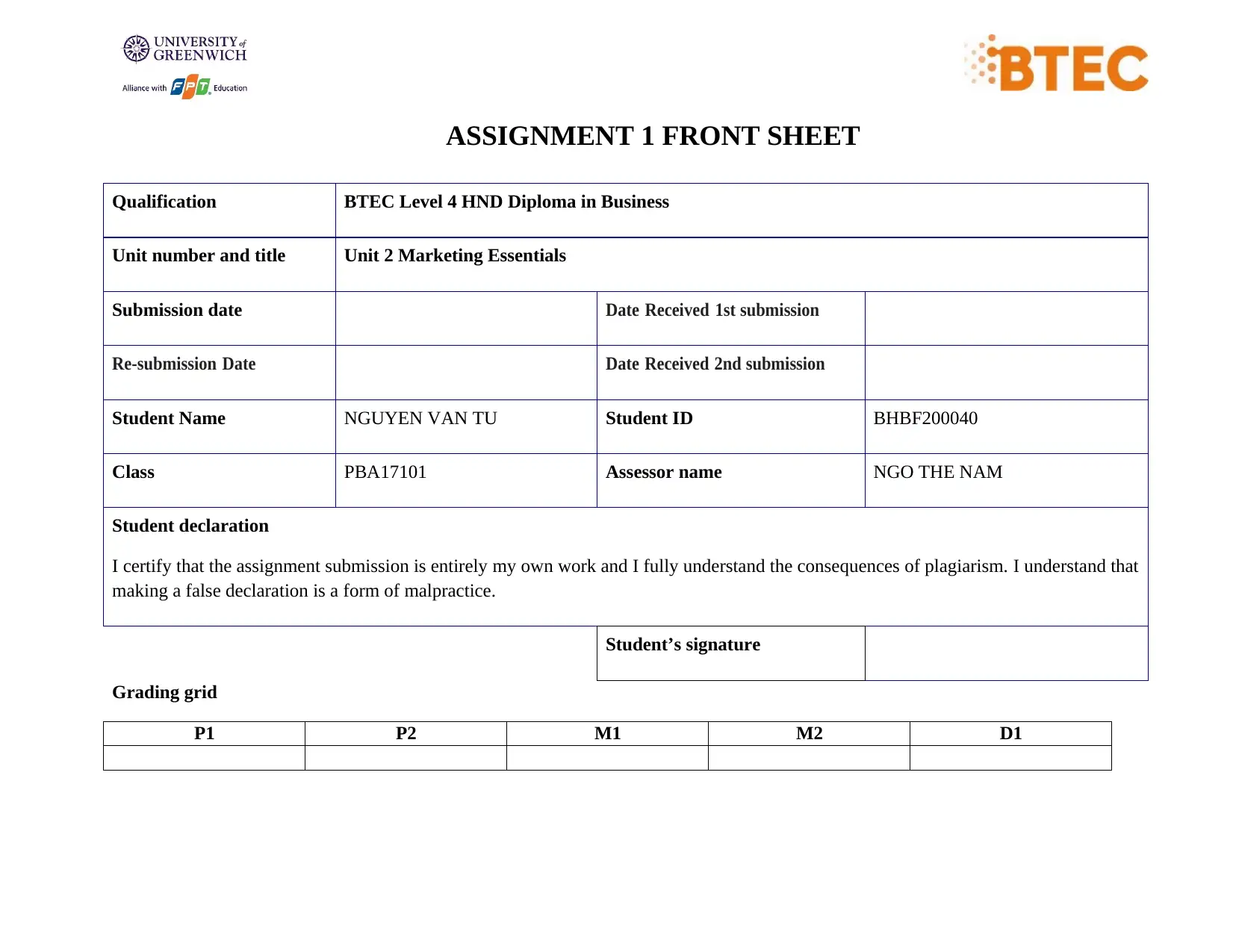
ASSIGNMENT 1 FRONT SHEET
Qualification BTEC Level 4 HND Diploma in Business
Unit number and title Unit 2 Marketing Essentials
Submission date Date Received 1st submission
Re-submission Date Date Received 2nd submission
Student Name NGUYEN VAN TU Student ID BHBF200040
Class PBA17101 Assessor name NGO THE NAM
Student declaration
I certify that the assignment submission is entirely my own work and I fully understand the consequences of plagiarism. I understand that
making a false declaration is a form of malpractice.
Student’s signature
Grading grid
P1 P2 M1 M2 D1
Qualification BTEC Level 4 HND Diploma in Business
Unit number and title Unit 2 Marketing Essentials
Submission date Date Received 1st submission
Re-submission Date Date Received 2nd submission
Student Name NGUYEN VAN TU Student ID BHBF200040
Class PBA17101 Assessor name NGO THE NAM
Student declaration
I certify that the assignment submission is entirely my own work and I fully understand the consequences of plagiarism. I understand that
making a false declaration is a form of malpractice.
Student’s signature
Grading grid
P1 P2 M1 M2 D1
Paraphrase This Document
Need a fresh take? Get an instant paraphrase of this document with our AI Paraphraser

Summative Feedback: Resubmission Feedback:
Grade: Assessor Signature: Date:
Internal Verifier’s Comments:
Signature & Date:
Grade: Assessor Signature: Date:
Internal Verifier’s Comments:
Signature & Date:
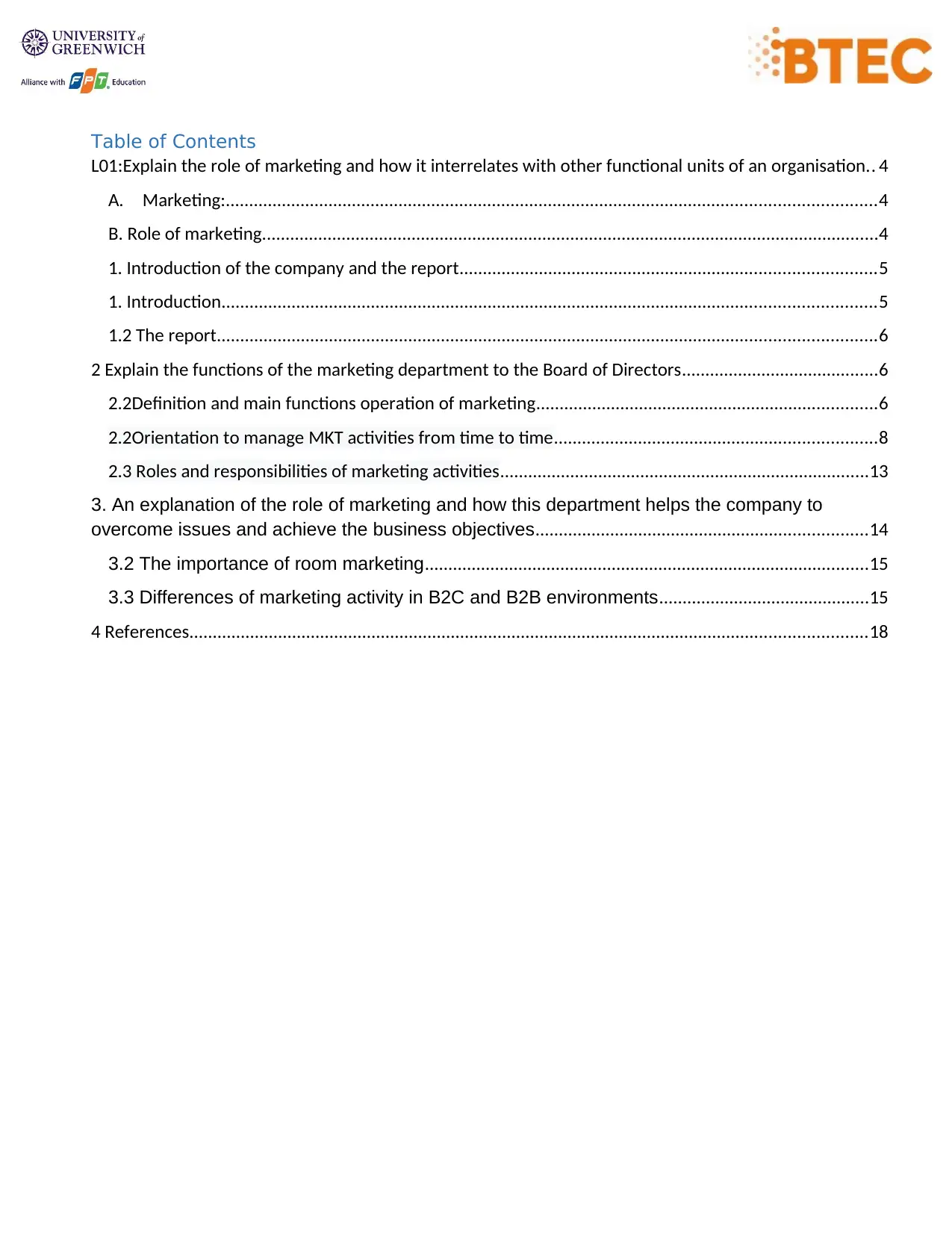
Table of Contents
L01:Explain the role of marketing and how it interrelates with other functional units of an organisation.. 4
A. Marketing:...........................................................................................................................................4
B. Role of marketing....................................................................................................................................4
1. Introduction of the company and the report.........................................................................................5
1. Introduction............................................................................................................................................5
1.2 The report.............................................................................................................................................6
2 Explain the functions of the marketing department to the Board of Directors..........................................6
2.2Definition and main functions operation of marketing.........................................................................6
2.2Orientation to manage MKT activities from time to time.....................................................................8
2.3 Roles and responsibilities of marketing activities...............................................................................13
3. An explanation of the role of marketing and how this department helps the company to
overcome issues and achieve the business objectives.......................................................................14
3.2 The importance of room marketing...............................................................................................15
3.3 Differences of marketing activity in B2C and B2B environments.............................................15
4 References.................................................................................................................................................18
L01:Explain the role of marketing and how it interrelates with other functional units of an organisation.. 4
A. Marketing:...........................................................................................................................................4
B. Role of marketing....................................................................................................................................4
1. Introduction of the company and the report.........................................................................................5
1. Introduction............................................................................................................................................5
1.2 The report.............................................................................................................................................6
2 Explain the functions of the marketing department to the Board of Directors..........................................6
2.2Definition and main functions operation of marketing.........................................................................6
2.2Orientation to manage MKT activities from time to time.....................................................................8
2.3 Roles and responsibilities of marketing activities...............................................................................13
3. An explanation of the role of marketing and how this department helps the company to
overcome issues and achieve the business objectives.......................................................................14
3.2 The importance of room marketing...............................................................................................15
3.3 Differences of marketing activity in B2C and B2B environments.............................................15
4 References.................................................................................................................................................18
⊘ This is a preview!⊘
Do you want full access?
Subscribe today to unlock all pages.

Trusted by 1+ million students worldwide
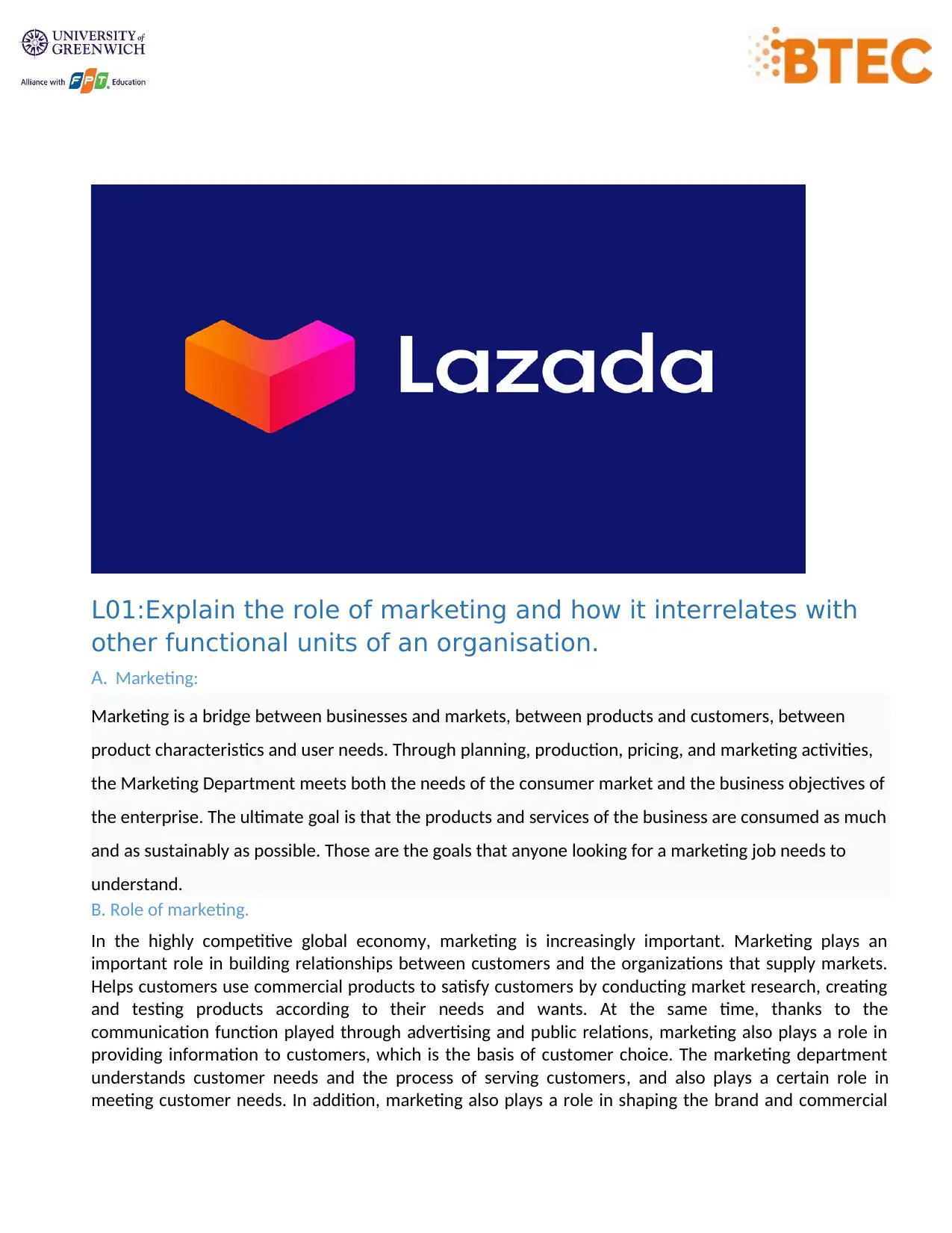
L01:Explain the role of marketing and how it interrelates with
other functional units of an organisation.
A. Marketing:
Marketing is a bridge between businesses and markets, between products and customers, between
product characteristics and user needs. Through planning, production, pricing, and marketing activities,
the Marketing Department meets both the needs of the consumer market and the business objectives of
the enterprise. The ultimate goal is that the products and services of the business are consumed as much
and as sustainably as possible. Those are the goals that anyone looking for a marketing job needs to
understand.
B. Role of marketing.
In the highly competitive global economy, marketing is increasingly important. Marketing plays an
important role in building relationships between customers and the organizations that supply markets.
Helps customers use commercial products to satisfy customers by conducting market research, creating
and testing products according to their needs and wants. At the same time, thanks to the
communication function played through advertising and public relations, marketing also plays a role in
providing information to customers, which is the basis of customer choice. The marketing department
understands customer needs and the process of serving customers, and also plays a certain role in
meeting customer needs. In addition, marketing also plays a role in shaping the brand and commercial
other functional units of an organisation.
A. Marketing:
Marketing is a bridge between businesses and markets, between products and customers, between
product characteristics and user needs. Through planning, production, pricing, and marketing activities,
the Marketing Department meets both the needs of the consumer market and the business objectives of
the enterprise. The ultimate goal is that the products and services of the business are consumed as much
and as sustainably as possible. Those are the goals that anyone looking for a marketing job needs to
understand.
B. Role of marketing.
In the highly competitive global economy, marketing is increasingly important. Marketing plays an
important role in building relationships between customers and the organizations that supply markets.
Helps customers use commercial products to satisfy customers by conducting market research, creating
and testing products according to their needs and wants. At the same time, thanks to the
communication function played through advertising and public relations, marketing also plays a role in
providing information to customers, which is the basis of customer choice. The marketing department
understands customer needs and the process of serving customers, and also plays a certain role in
meeting customer needs. In addition, marketing also plays a role in shaping the brand and commercial
Paraphrase This Document
Need a fresh take? Get an instant paraphrase of this document with our AI Paraphraser
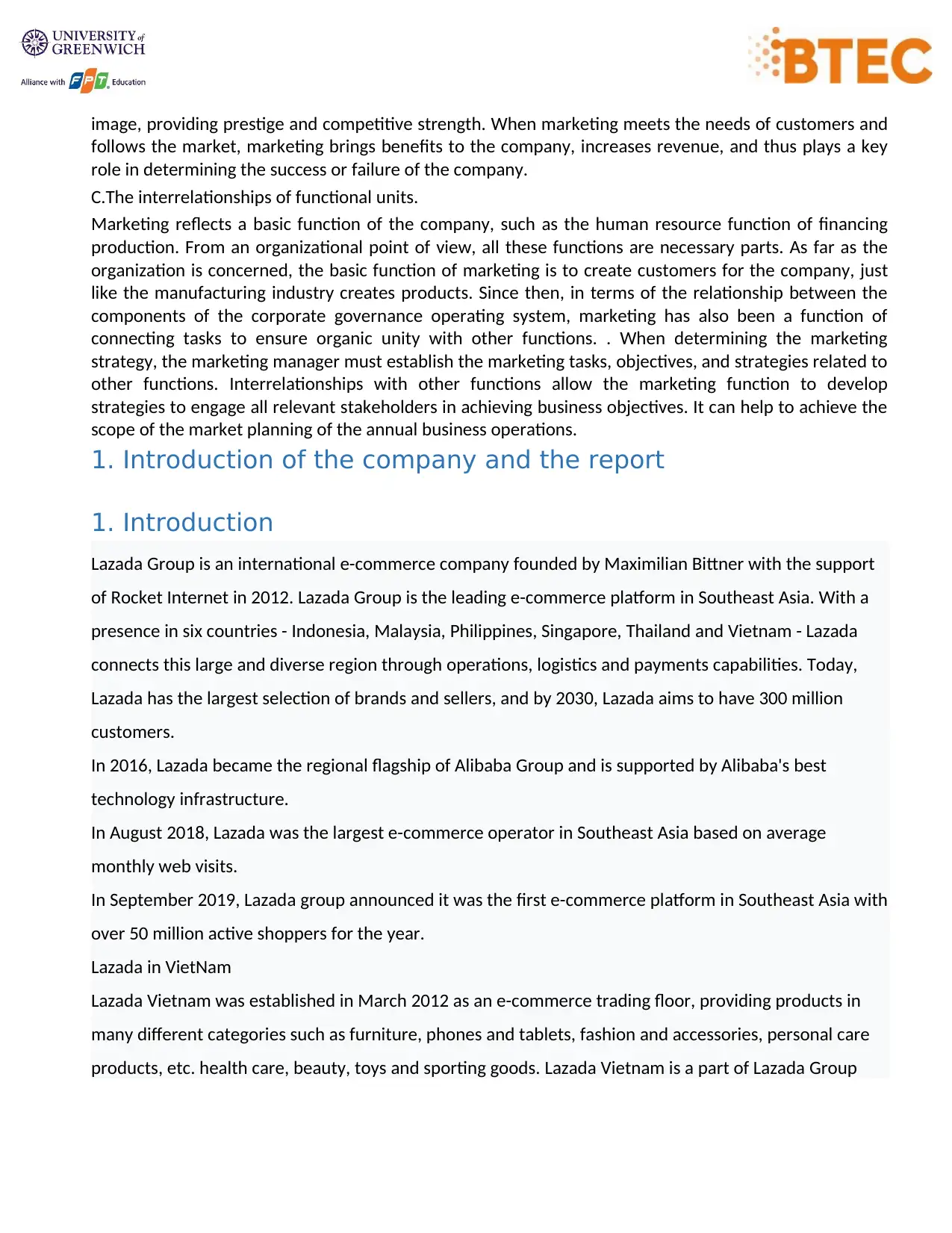
image, providing prestige and competitive strength. When marketing meets the needs of customers and
follows the market, marketing brings benefits to the company, increases revenue, and thus plays a key
role in determining the success or failure of the company.
C.The interrelationships of functional units.
Marketing reflects a basic function of the company, such as the human resource function of financing
production. From an organizational point of view, all these functions are necessary parts. As far as the
organization is concerned, the basic function of marketing is to create customers for the company, just
like the manufacturing industry creates products. Since then, in terms of the relationship between the
components of the corporate governance operating system, marketing has also been a function of
connecting tasks to ensure organic unity with other functions. . When determining the marketing
strategy, the marketing manager must establish the marketing tasks, objectives, and strategies related to
other functions. Interrelationships with other functions allow the marketing function to develop
strategies to engage all relevant stakeholders in achieving business objectives. It can help to achieve the
scope of the market planning of the annual business operations.
1. Introduction of the company and the report
1. Introduction
Lazada Group is an international e-commerce company founded by Maximilian Bittner with the support
of Rocket Internet in 2012. Lazada Group is the leading e-commerce platform in Southeast Asia. With a
presence in six countries - Indonesia, Malaysia, Philippines, Singapore, Thailand and Vietnam - Lazada
connects this large and diverse region through operations, logistics and payments capabilities. Today,
Lazada has the largest selection of brands and sellers, and by 2030, Lazada aims to have 300 million
customers.
In 2016, Lazada became the regional flagship of Alibaba Group and is supported by Alibaba's best
technology infrastructure.
In August 2018, Lazada was the largest e-commerce operator in Southeast Asia based on average
monthly web visits.
In September 2019, Lazada group announced it was the first e-commerce platform in Southeast Asia with
over 50 million active shoppers for the year.
Lazada in VietNam
Lazada Vietnam was established in March 2012 as an e-commerce trading floor, providing products in
many different categories such as furniture, phones and tablets, fashion and accessories, personal care
products, etc. health care, beauty, toys and sporting goods. Lazada Vietnam is a part of Lazada Group
follows the market, marketing brings benefits to the company, increases revenue, and thus plays a key
role in determining the success or failure of the company.
C.The interrelationships of functional units.
Marketing reflects a basic function of the company, such as the human resource function of financing
production. From an organizational point of view, all these functions are necessary parts. As far as the
organization is concerned, the basic function of marketing is to create customers for the company, just
like the manufacturing industry creates products. Since then, in terms of the relationship between the
components of the corporate governance operating system, marketing has also been a function of
connecting tasks to ensure organic unity with other functions. . When determining the marketing
strategy, the marketing manager must establish the marketing tasks, objectives, and strategies related to
other functions. Interrelationships with other functions allow the marketing function to develop
strategies to engage all relevant stakeholders in achieving business objectives. It can help to achieve the
scope of the market planning of the annual business operations.
1. Introduction of the company and the report
1. Introduction
Lazada Group is an international e-commerce company founded by Maximilian Bittner with the support
of Rocket Internet in 2012. Lazada Group is the leading e-commerce platform in Southeast Asia. With a
presence in six countries - Indonesia, Malaysia, Philippines, Singapore, Thailand and Vietnam - Lazada
connects this large and diverse region through operations, logistics and payments capabilities. Today,
Lazada has the largest selection of brands and sellers, and by 2030, Lazada aims to have 300 million
customers.
In 2016, Lazada became the regional flagship of Alibaba Group and is supported by Alibaba's best
technology infrastructure.
In August 2018, Lazada was the largest e-commerce operator in Southeast Asia based on average
monthly web visits.
In September 2019, Lazada group announced it was the first e-commerce platform in Southeast Asia with
over 50 million active shoppers for the year.
Lazada in VietNam
Lazada Vietnam was established in March 2012 as an e-commerce trading floor, providing products in
many different categories such as furniture, phones and tablets, fashion and accessories, personal care
products, etc. health care, beauty, toys and sporting goods. Lazada Vietnam is a part of Lazada Group
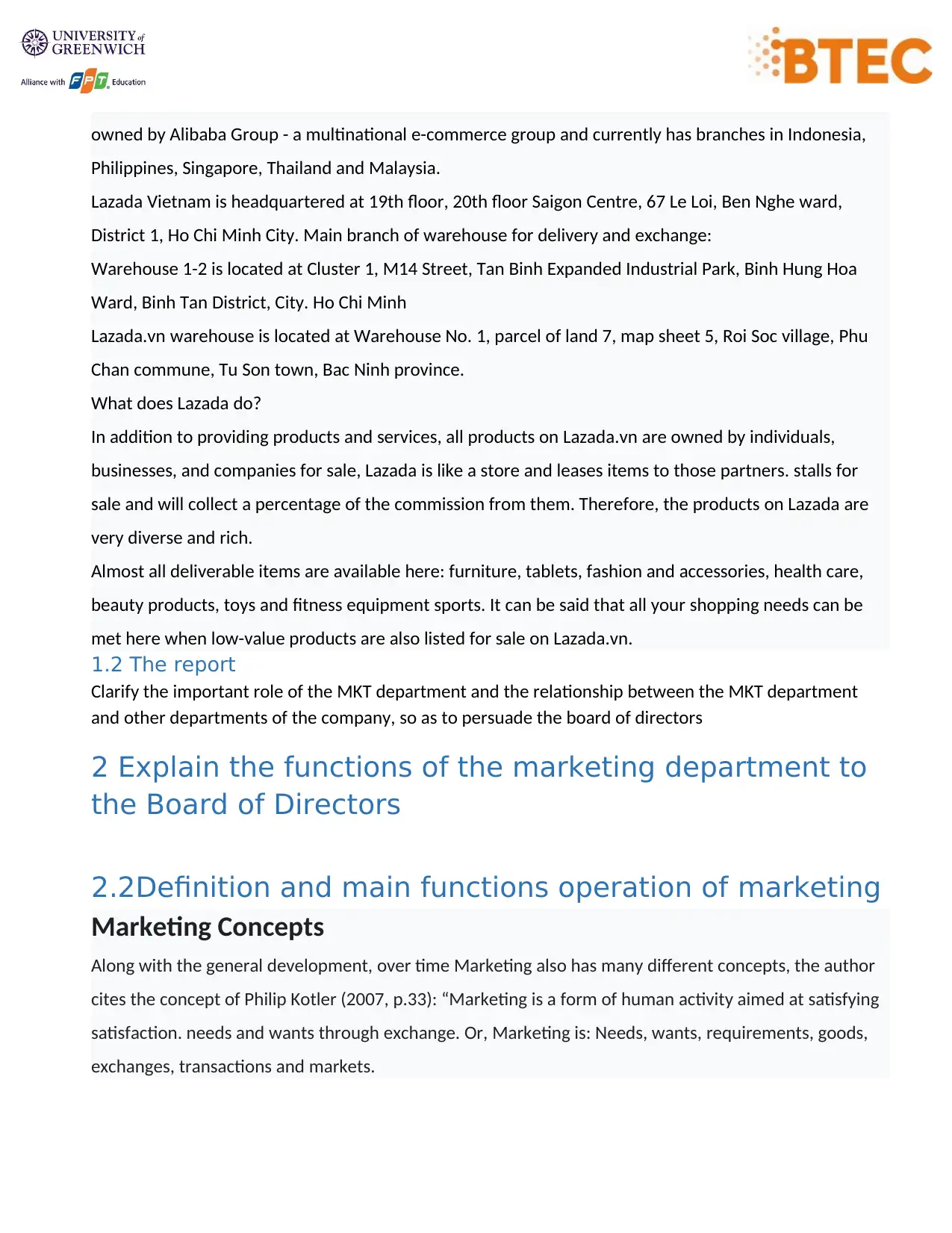
owned by Alibaba Group - a multinational e-commerce group and currently has branches in Indonesia,
Philippines, Singapore, Thailand and Malaysia.
Lazada Vietnam is headquartered at 19th floor, 20th floor Saigon Centre, 67 Le Loi, Ben Nghe ward,
District 1, Ho Chi Minh City. Main branch of warehouse for delivery and exchange:
Warehouse 1-2 is located at Cluster 1, M14 Street, Tan Binh Expanded Industrial Park, Binh Hung Hoa
Ward, Binh Tan District, City. Ho Chi Minh
Lazada.vn warehouse is located at Warehouse No. 1, parcel of land 7, map sheet 5, Roi Soc village, Phu
Chan commune, Tu Son town, Bac Ninh province.
What does Lazada do?
In addition to providing products and services, all products on Lazada.vn are owned by individuals,
businesses, and companies for sale, Lazada is like a store and leases items to those partners. stalls for
sale and will collect a percentage of the commission from them. Therefore, the products on Lazada are
very diverse and rich.
Almost all deliverable items are available here: furniture, tablets, fashion and accessories, health care,
beauty products, toys and fitness equipment sports. It can be said that all your shopping needs can be
met here when low-value products are also listed for sale on Lazada.vn.
1.2 The report
Clarify the important role of the MKT department and the relationship between the MKT department
and other departments of the company, so as to persuade the board of directors
2 Explain the functions of the marketing department to
the Board of Directors
2.2Definition and main functions operation of marketing
Marketing Concepts
Along with the general development, over time Marketing also has many different concepts, the author
cites the concept of Philip Kotler (2007, p.33): “Marketing is a form of human activity aimed at satisfying
satisfaction. needs and wants through exchange. Or, Marketing is: Needs, wants, requirements, goods,
exchanges, transactions and markets.
Philippines, Singapore, Thailand and Malaysia.
Lazada Vietnam is headquartered at 19th floor, 20th floor Saigon Centre, 67 Le Loi, Ben Nghe ward,
District 1, Ho Chi Minh City. Main branch of warehouse for delivery and exchange:
Warehouse 1-2 is located at Cluster 1, M14 Street, Tan Binh Expanded Industrial Park, Binh Hung Hoa
Ward, Binh Tan District, City. Ho Chi Minh
Lazada.vn warehouse is located at Warehouse No. 1, parcel of land 7, map sheet 5, Roi Soc village, Phu
Chan commune, Tu Son town, Bac Ninh province.
What does Lazada do?
In addition to providing products and services, all products on Lazada.vn are owned by individuals,
businesses, and companies for sale, Lazada is like a store and leases items to those partners. stalls for
sale and will collect a percentage of the commission from them. Therefore, the products on Lazada are
very diverse and rich.
Almost all deliverable items are available here: furniture, tablets, fashion and accessories, health care,
beauty products, toys and fitness equipment sports. It can be said that all your shopping needs can be
met here when low-value products are also listed for sale on Lazada.vn.
1.2 The report
Clarify the important role of the MKT department and the relationship between the MKT department
and other departments of the company, so as to persuade the board of directors
2 Explain the functions of the marketing department to
the Board of Directors
2.2Definition and main functions operation of marketing
Marketing Concepts
Along with the general development, over time Marketing also has many different concepts, the author
cites the concept of Philip Kotler (2007, p.33): “Marketing is a form of human activity aimed at satisfying
satisfaction. needs and wants through exchange. Or, Marketing is: Needs, wants, requirements, goods,
exchanges, transactions and markets.
⊘ This is a preview!⊘
Do you want full access?
Subscribe today to unlock all pages.

Trusted by 1+ million students worldwide
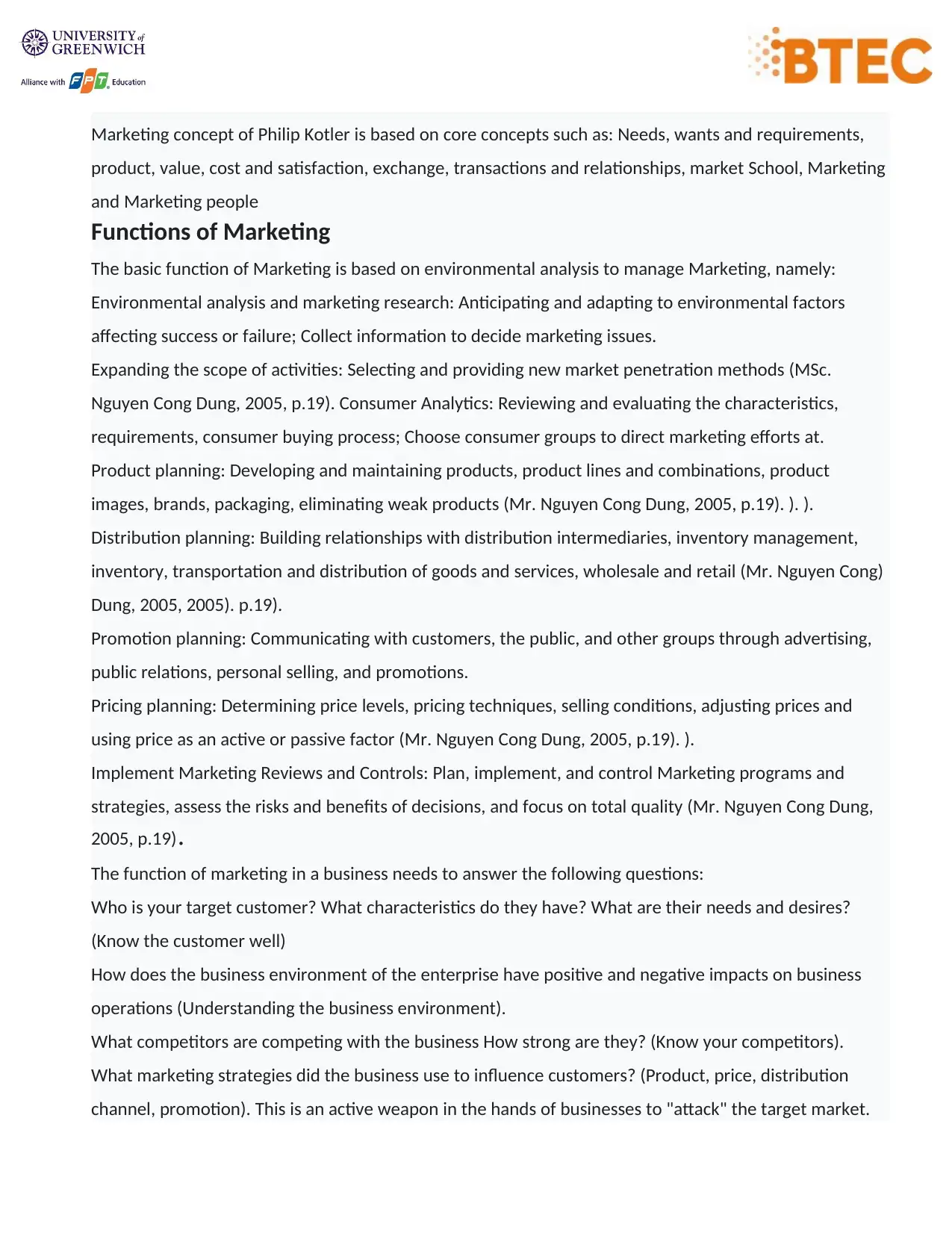
Marketing concept of Philip Kotler is based on core concepts such as: Needs, wants and requirements,
product, value, cost and satisfaction, exchange, transactions and relationships, market School, Marketing
and Marketing people
Functions of Marketing
The basic function of Marketing is based on environmental analysis to manage Marketing, namely:
Environmental analysis and marketing research: Anticipating and adapting to environmental factors
affecting success or failure; Collect information to decide marketing issues.
Expanding the scope of activities: Selecting and providing new market penetration methods (MSc.
Nguyen Cong Dung, 2005, p.19). Consumer Analytics: Reviewing and evaluating the characteristics,
requirements, consumer buying process; Choose consumer groups to direct marketing efforts at.
Product planning: Developing and maintaining products, product lines and combinations, product
images, brands, packaging, eliminating weak products (Mr. Nguyen Cong Dung, 2005, p.19). ). ).
Distribution planning: Building relationships with distribution intermediaries, inventory management,
inventory, transportation and distribution of goods and services, wholesale and retail (Mr. Nguyen Cong)
Dung, 2005, 2005). p.19).
Promotion planning: Communicating with customers, the public, and other groups through advertising,
public relations, personal selling, and promotions.
Pricing planning: Determining price levels, pricing techniques, selling conditions, adjusting prices and
using price as an active or passive factor (Mr. Nguyen Cong Dung, 2005, p.19). ).
Implement Marketing Reviews and Controls: Plan, implement, and control Marketing programs and
strategies, assess the risks and benefits of decisions, and focus on total quality (Mr. Nguyen Cong Dung,
2005, p.19).
The function of marketing in a business needs to answer the following questions:
Who is your target customer? What characteristics do they have? What are their needs and desires?
(Know the customer well)
How does the business environment of the enterprise have positive and negative impacts on business
operations (Understanding the business environment).
What competitors are competing with the business How strong are they? (Know your competitors).
What marketing strategies did the business use to influence customers? (Product, price, distribution
channel, promotion). This is an active weapon in the hands of businesses to "attack" the target market.
product, value, cost and satisfaction, exchange, transactions and relationships, market School, Marketing
and Marketing people
Functions of Marketing
The basic function of Marketing is based on environmental analysis to manage Marketing, namely:
Environmental analysis and marketing research: Anticipating and adapting to environmental factors
affecting success or failure; Collect information to decide marketing issues.
Expanding the scope of activities: Selecting and providing new market penetration methods (MSc.
Nguyen Cong Dung, 2005, p.19). Consumer Analytics: Reviewing and evaluating the characteristics,
requirements, consumer buying process; Choose consumer groups to direct marketing efforts at.
Product planning: Developing and maintaining products, product lines and combinations, product
images, brands, packaging, eliminating weak products (Mr. Nguyen Cong Dung, 2005, p.19). ). ).
Distribution planning: Building relationships with distribution intermediaries, inventory management,
inventory, transportation and distribution of goods and services, wholesale and retail (Mr. Nguyen Cong)
Dung, 2005, 2005). p.19).
Promotion planning: Communicating with customers, the public, and other groups through advertising,
public relations, personal selling, and promotions.
Pricing planning: Determining price levels, pricing techniques, selling conditions, adjusting prices and
using price as an active or passive factor (Mr. Nguyen Cong Dung, 2005, p.19). ).
Implement Marketing Reviews and Controls: Plan, implement, and control Marketing programs and
strategies, assess the risks and benefits of decisions, and focus on total quality (Mr. Nguyen Cong Dung,
2005, p.19).
The function of marketing in a business needs to answer the following questions:
Who is your target customer? What characteristics do they have? What are their needs and desires?
(Know the customer well)
How does the business environment of the enterprise have positive and negative impacts on business
operations (Understanding the business environment).
What competitors are competing with the business How strong are they? (Know your competitors).
What marketing strategies did the business use to influence customers? (Product, price, distribution
channel, promotion). This is an active weapon in the hands of businesses to "attack" the target market.
Paraphrase This Document
Need a fresh take? Get an instant paraphrase of this document with our AI Paraphraser
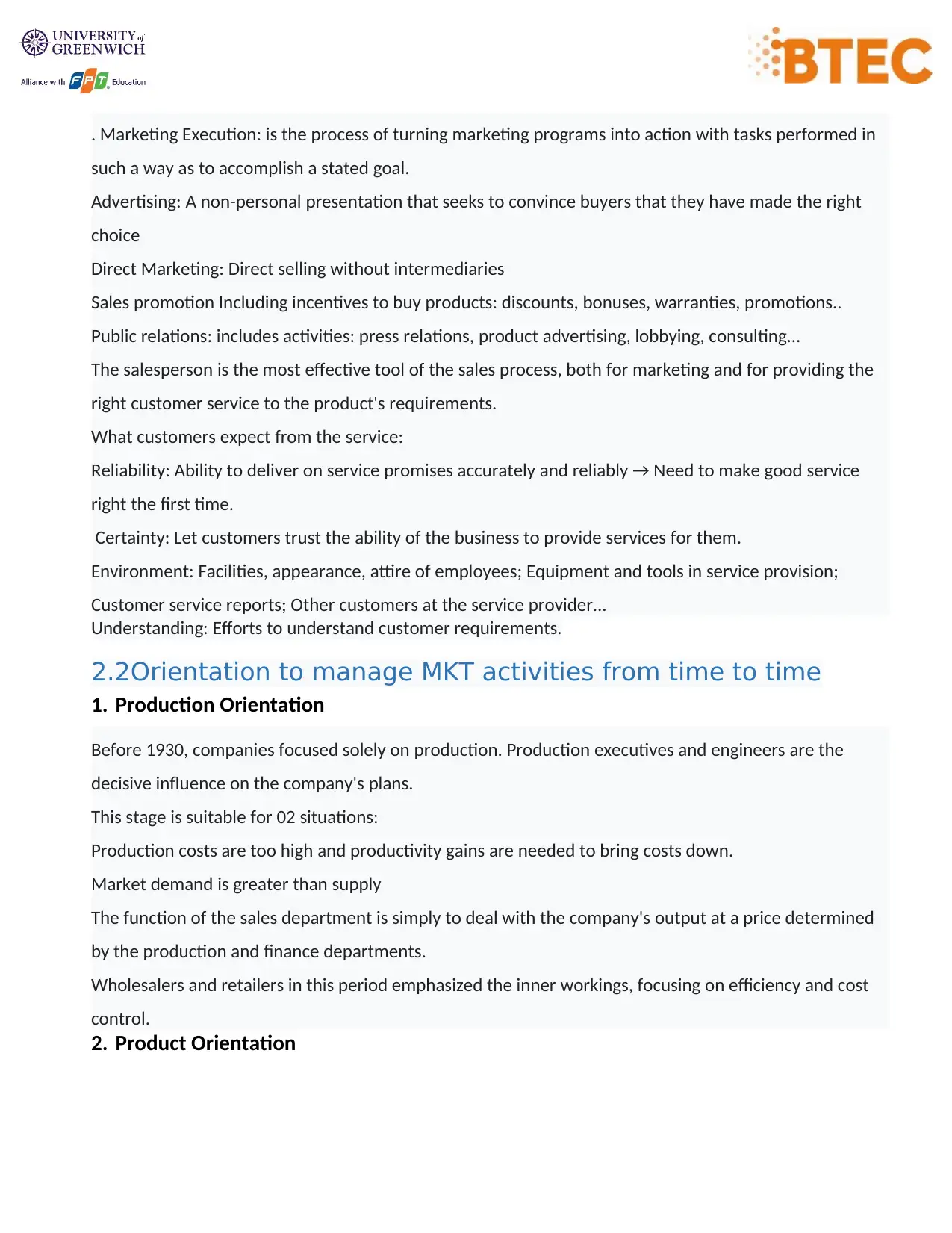
. Marketing Execution: is the process of turning marketing programs into action with tasks performed in
such a way as to accomplish a stated goal.
Advertising: A non-personal presentation that seeks to convince buyers that they have made the right
choice
Direct Marketing: Direct selling without intermediaries
Sales promotion Including incentives to buy products: discounts, bonuses, warranties, promotions..
Public relations: includes activities: press relations, product advertising, lobbying, consulting...
The salesperson is the most effective tool of the sales process, both for marketing and for providing the
right customer service to the product's requirements.
What customers expect from the service:
Reliability: Ability to deliver on service promises accurately and reliably → Need to make good service
right the first time.
Certainty: Let customers trust the ability of the business to provide services for them.
Environment: Facilities, appearance, attire of employees; Equipment and tools in service provision;
Customer service reports; Other customers at the service provider...
Understanding: Efforts to understand customer requirements.
2.2Orientation to manage MKT activities from time to time
1. Production Orientation
Before 1930, companies focused solely on production. Production executives and engineers are the
decisive influence on the company's plans.
This stage is suitable for 02 situations:
Production costs are too high and productivity gains are needed to bring costs down.
Market demand is greater than supply
The function of the sales department is simply to deal with the company's output at a price determined
by the production and finance departments.
Wholesalers and retailers in this period emphasized the inner workings, focusing on efficiency and cost
control.
2. Product Orientation
such a way as to accomplish a stated goal.
Advertising: A non-personal presentation that seeks to convince buyers that they have made the right
choice
Direct Marketing: Direct selling without intermediaries
Sales promotion Including incentives to buy products: discounts, bonuses, warranties, promotions..
Public relations: includes activities: press relations, product advertising, lobbying, consulting...
The salesperson is the most effective tool of the sales process, both for marketing and for providing the
right customer service to the product's requirements.
What customers expect from the service:
Reliability: Ability to deliver on service promises accurately and reliably → Need to make good service
right the first time.
Certainty: Let customers trust the ability of the business to provide services for them.
Environment: Facilities, appearance, attire of employees; Equipment and tools in service provision;
Customer service reports; Other customers at the service provider...
Understanding: Efforts to understand customer requirements.
2.2Orientation to manage MKT activities from time to time
1. Production Orientation
Before 1930, companies focused solely on production. Production executives and engineers are the
decisive influence on the company's plans.
This stage is suitable for 02 situations:
Production costs are too high and productivity gains are needed to bring costs down.
Market demand is greater than supply
The function of the sales department is simply to deal with the company's output at a price determined
by the production and finance departments.
Wholesalers and retailers in this period emphasized the inner workings, focusing on efficiency and cost
control.
2. Product Orientation
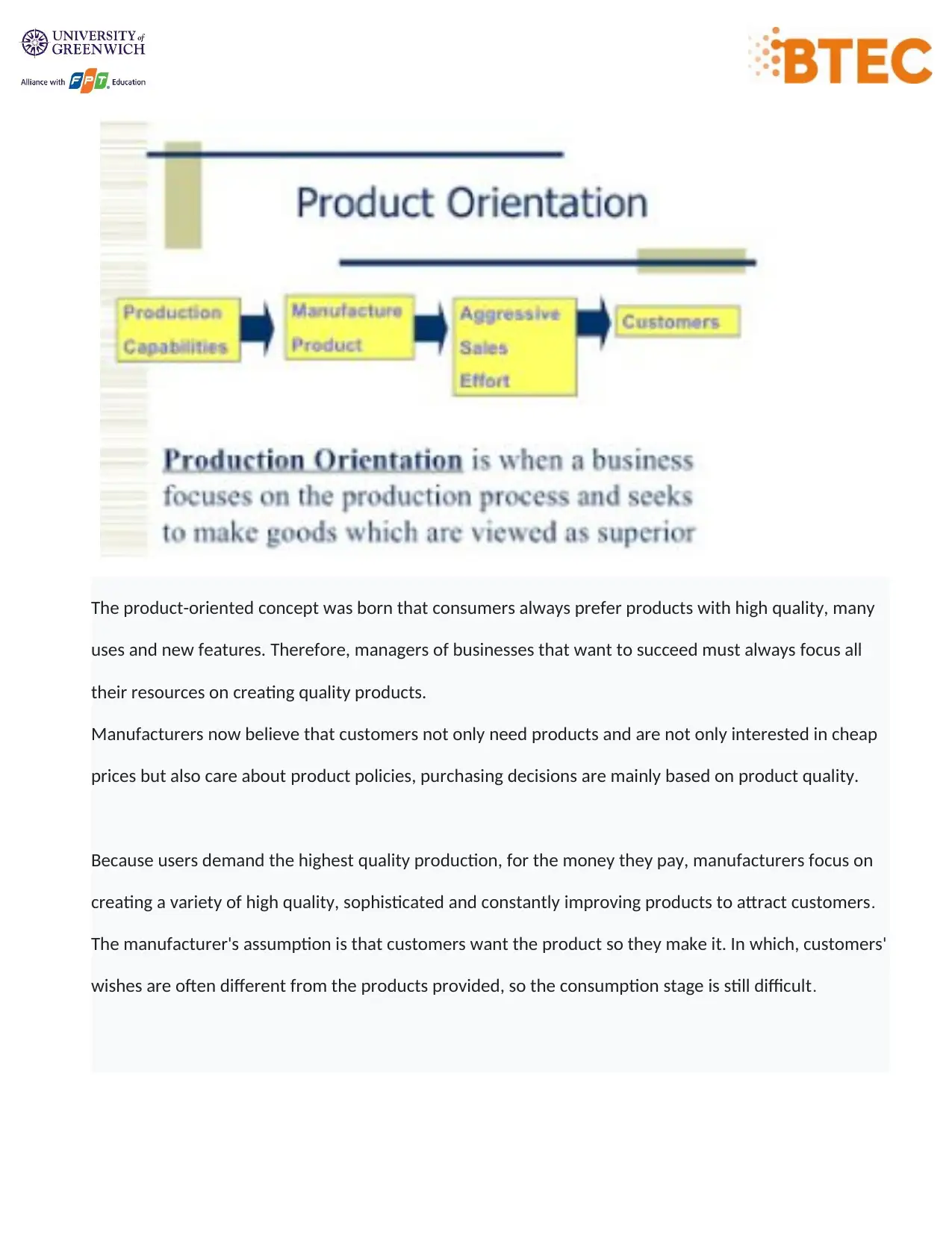
The product-oriented concept was born that consumers always prefer products with high quality, many
uses and new features. Therefore, managers of businesses that want to succeed must always focus all
their resources on creating quality products.
Manufacturers now believe that customers not only need products and are not only interested in cheap
prices but also care about product policies, purchasing decisions are mainly based on product quality.
Because users demand the highest quality production, for the money they pay, manufacturers focus on
creating a variety of high quality, sophisticated and constantly improving products to attract customers.
The manufacturer's assumption is that customers want the product so they make it. In which, customers'
wishes are often different from the products provided, so the consumption stage is still difficult.
uses and new features. Therefore, managers of businesses that want to succeed must always focus all
their resources on creating quality products.
Manufacturers now believe that customers not only need products and are not only interested in cheap
prices but also care about product policies, purchasing decisions are mainly based on product quality.
Because users demand the highest quality production, for the money they pay, manufacturers focus on
creating a variety of high quality, sophisticated and constantly improving products to attract customers.
The manufacturer's assumption is that customers want the product so they make it. In which, customers'
wishes are often different from the products provided, so the consumption stage is still difficult.
⊘ This is a preview!⊘
Do you want full access?
Subscribe today to unlock all pages.

Trusted by 1+ million students worldwide
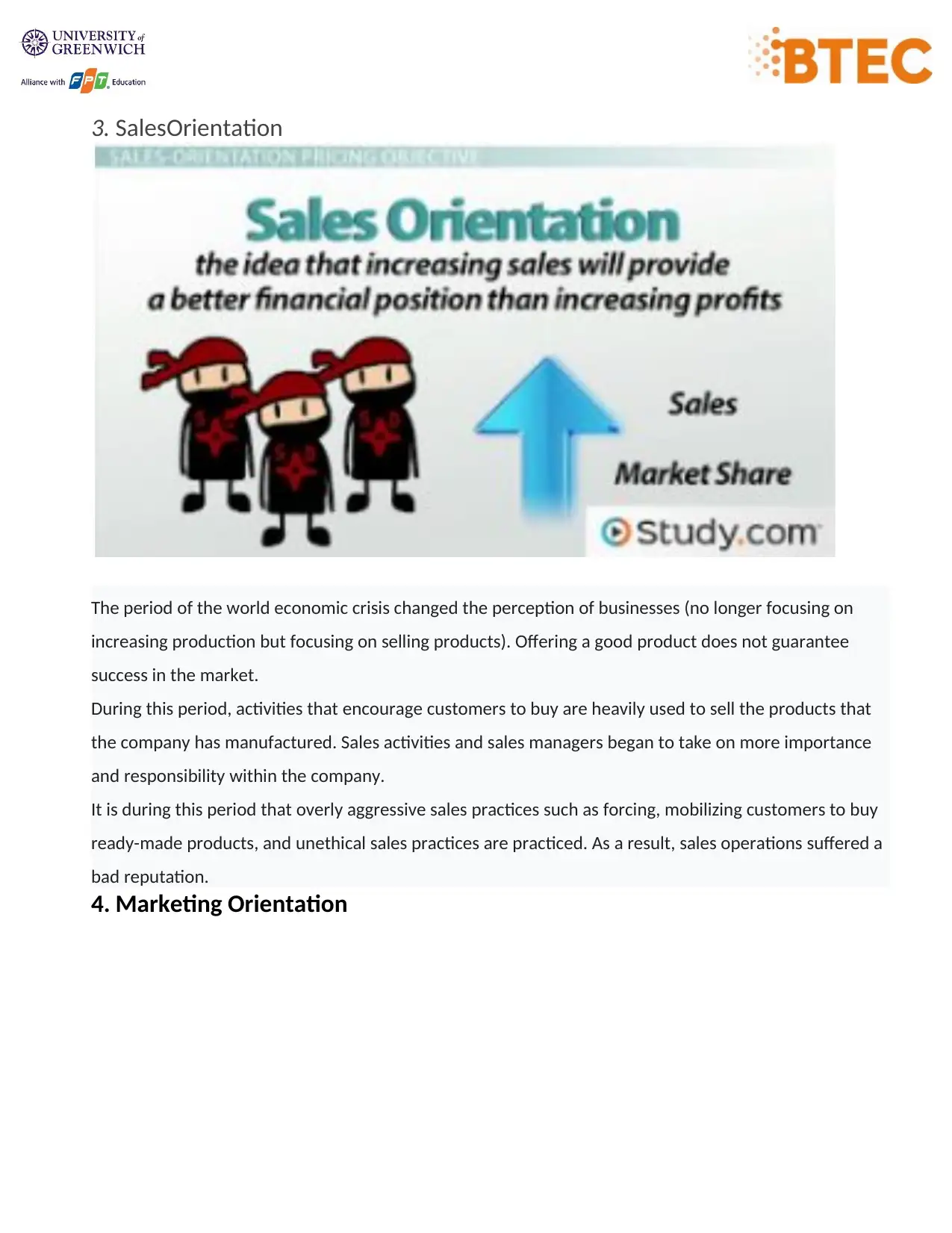
3. SalesOrientation
The period of the world economic crisis changed the perception of businesses (no longer focusing on
increasing production but focusing on selling products). Offering a good product does not guarantee
success in the market.
During this period, activities that encourage customers to buy are heavily used to sell the products that
the company has manufactured. Sales activities and sales managers began to take on more importance
and responsibility within the company.
It is during this period that overly aggressive sales practices such as forcing, mobilizing customers to buy
ready-made products, and unethical sales practices are practiced. As a result, sales operations suffered a
bad reputation.
4. Marketing Orientation
The period of the world economic crisis changed the perception of businesses (no longer focusing on
increasing production but focusing on selling products). Offering a good product does not guarantee
success in the market.
During this period, activities that encourage customers to buy are heavily used to sell the products that
the company has manufactured. Sales activities and sales managers began to take on more importance
and responsibility within the company.
It is during this period that overly aggressive sales practices such as forcing, mobilizing customers to buy
ready-made products, and unethical sales practices are practiced. As a result, sales operations suffered a
bad reputation.
4. Marketing Orientation
Paraphrase This Document
Need a fresh take? Get an instant paraphrase of this document with our AI Paraphraser
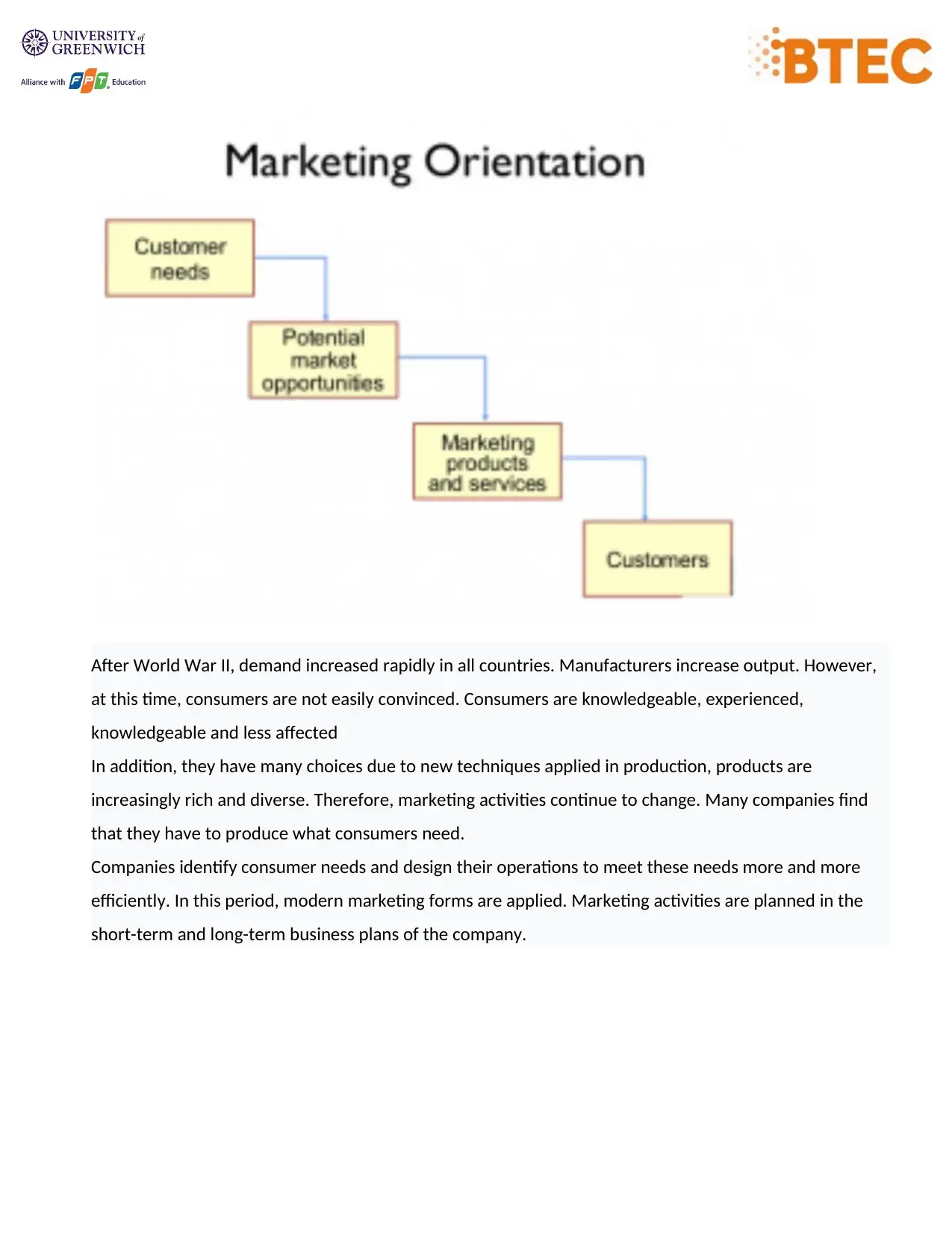
After World War II, demand increased rapidly in all countries. Manufacturers increase output. However,
at this time, consumers are not easily convinced. Consumers are knowledgeable, experienced,
knowledgeable and less affected
In addition, they have many choices due to new techniques applied in production, products are
increasingly rich and diverse. Therefore, marketing activities continue to change. Many companies find
that they have to produce what consumers need.
Companies identify consumer needs and design their operations to meet these needs more and more
efficiently. In this period, modern marketing forms are applied. Marketing activities are planned in the
short-term and long-term business plans of the company.
at this time, consumers are not easily convinced. Consumers are knowledgeable, experienced,
knowledgeable and less affected
In addition, they have many choices due to new techniques applied in production, products are
increasingly rich and diverse. Therefore, marketing activities continue to change. Many companies find
that they have to produce what consumers need.
Companies identify consumer needs and design their operations to meet these needs more and more
efficiently. In this period, modern marketing forms are applied. Marketing activities are planned in the
short-term and long-term business plans of the company.
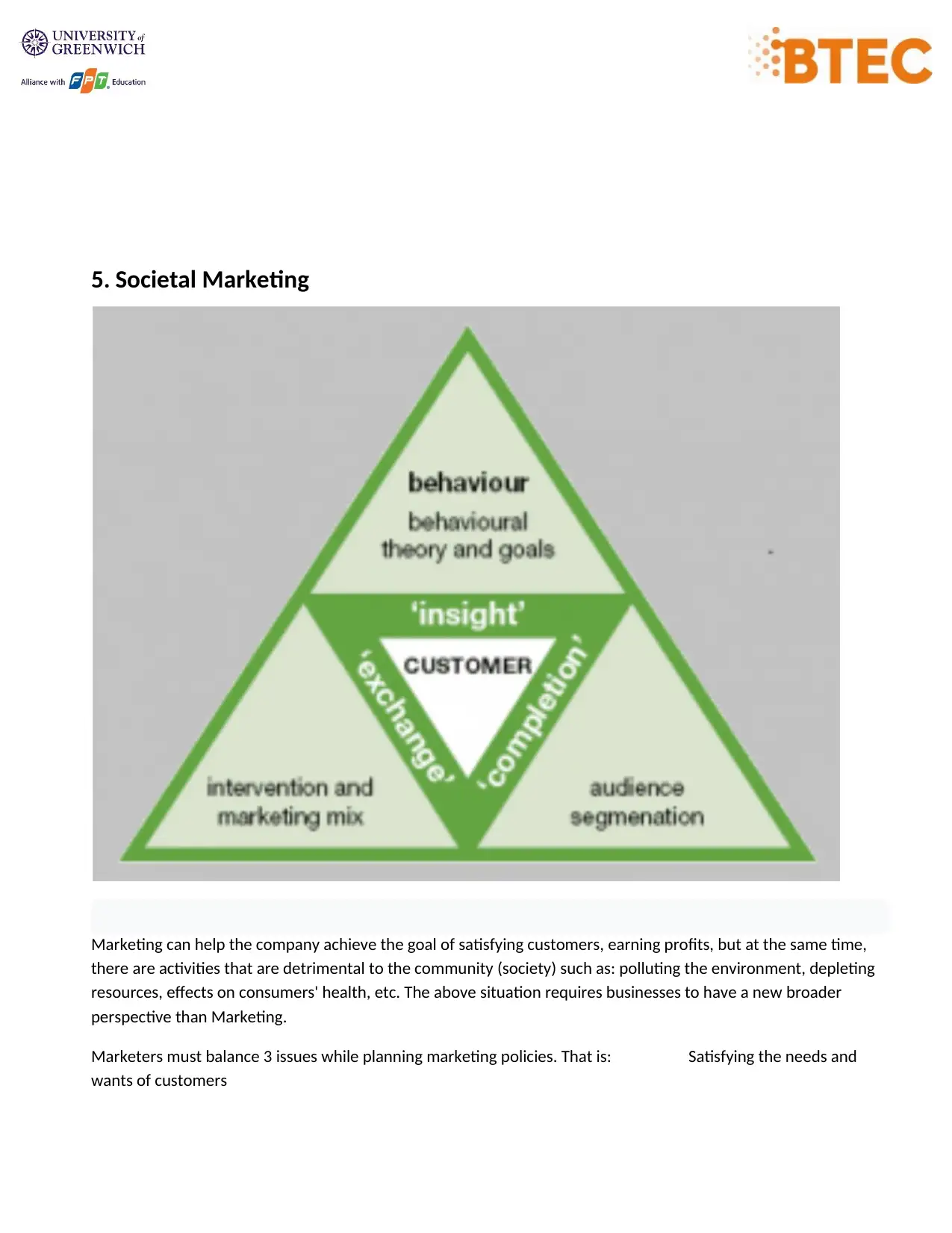
5. Societal Marketing
Marketing can help the company achieve the goal of satisfying customers, earning profits, but at the same time,
there are activities that are detrimental to the community (society) such as: polluting the environment, depleting
resources, effects on consumers' health, etc. The above situation requires businesses to have a new broader
perspective than Marketing.
Marketers must balance 3 issues while planning marketing policies. That is: Satisfying the needs and
wants of customers
Marketing can help the company achieve the goal of satisfying customers, earning profits, but at the same time,
there are activities that are detrimental to the community (society) such as: polluting the environment, depleting
resources, effects on consumers' health, etc. The above situation requires businesses to have a new broader
perspective than Marketing.
Marketers must balance 3 issues while planning marketing policies. That is: Satisfying the needs and
wants of customers
⊘ This is a preview!⊘
Do you want full access?
Subscribe today to unlock all pages.

Trusted by 1+ million students worldwide
1 out of 19
Related Documents
Your All-in-One AI-Powered Toolkit for Academic Success.
+13062052269
info@desklib.com
Available 24*7 on WhatsApp / Email
![[object Object]](/_next/static/media/star-bottom.7253800d.svg)
Unlock your academic potential
Copyright © 2020–2025 A2Z Services. All Rights Reserved. Developed and managed by ZUCOL.





